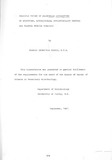| dc.description.abstract | Seventy one isolates of Salmonella livingstone were analysed
for homogenuity using biotyping, antimicrobial susceptibility
testing and plasmid profile analysis.
Biotyping distinguished Salmonella livingstone isolates into
4 biogroups. Biogroup 1 (45%) and 2 (36.6%) were the most prevalent
whereas biogroups 3 (9.9%) and 4 (8.5%) were rare.
Antimicrobial susceptibility testing revealed 6 antimicobial
resistant patterns with resistance to both streptomycin 10 ug
and compound sulphonomide 50 ug (18.6%) and, to compound sulphonamide
alone (18.6%) being the most common, followed by multiple
resistance to streptomycin, compound sulphonamide and sulphafu-
razole (17.1%) and those resistance to any of the above drugs
were 27.1 percent of the total.
All isolates were susceptible to ampicillin 10 ug (AMP), tetracycline
10 ug (TE), neomycin 10 ug (H), chloramphenicol 10,ug
(C), co-trimoxazole 25 ug (SXT), furazolidone 15 ug (FR), cephalorodine
25 ug (CR), kanamycin 30 ug (K), nalidixic acid 30 ug
(NA), gentamicin 10'ug (CN), colistin sulphate 10 ug (CT), and
carbenicillin 100 ug (CAR).
All the 71 isolates were resistant to cloxacillin 10 ug(OB),
fusidic acid 10 ug (FD), lincomycin 2 ug (MY), novobiocin 5 ug
(NV), penicillin G 1.5 ug (P), methicillin 10 ug (MET), enthromycin
10 ug (E) and sulphadiazine 50 ug (SD).
Only 46.8 percent of the Salmonella livingstone isolates had
plasmids. Of these, 82.8 percent had light plasmids of between
3.3 and 9.1 Mega daltons, 13.8 percent had heavy plasmids of
between 33 and 120 Mega daltons (Mda1), and 3.4 percent had both
light and heavy plasmids. There was no correlation between possession
of plasmids and antimicrobial resistance overall, but
within biogroups, there was some correlation.
Biotyping was even superior to antimicrobial susceptibility testing
in correlating isolates to source, and plasmid profile analysis
was more specific and superior to the other two methods
in correlating isolates to source even within the same biogroup.
The three methods used proved useful for tracing the sources of
Salmonella livingstone and are recommended in future epidemiological
studies of this serotype. | en |

